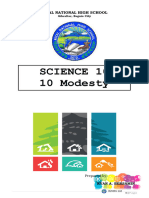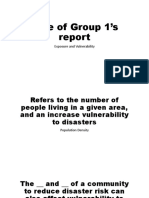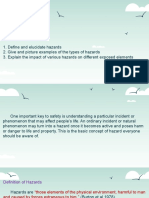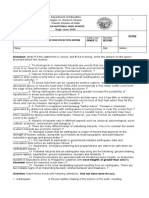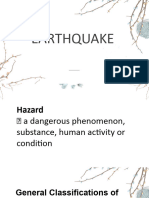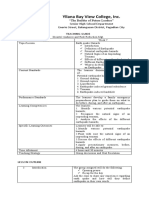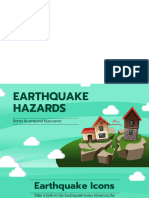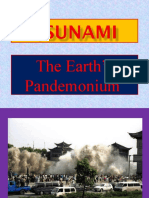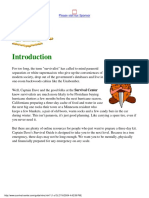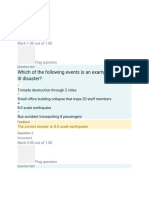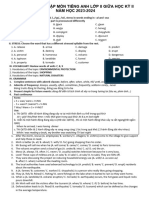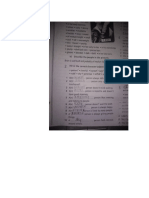2 1 Basic Concept of Hazard
Uploaded by
Debbie Fernandez2 1 Basic Concept of Hazard
Uploaded by
Debbie FernandezDISASTER RISK
MANAGEMENT FOR PUBLIC
SAFETY
Basic Concept of Hazard
Learning Outcomes
1.Define and elucidate hazards
2.Give and picture examples of the types of hazards
3.Explain the impact of various hazards on different
exposed elements
Definition of Hazards
Hazards are “those elements of the physical environment,
harmful to man and caused by forced extraneous to him.”
(Burton et al 1978)
Standards Australia (2000) defines hazard as:
“a source of potential harm or situation with potential
cause loss.”
Asian Disaster Preparedness Center (ADPC) describes hazard as:
:Z natural event that has a potential to cause harm or
loss.”
General Classification of Hazards
There are many different ways of
classifying hazards. One is to consider the
extent to which hazards are natural.
General Classification of Hazards
1. Natural hazards such as earthquakes or floods arise from purely
natural processes in the environment.
2. Quasi-natural hazards such as smog or desertification that arise
through the interaction of natural processes and human activities.
3. Technological (or human-made) hazards such as the toxicity of
pesticides to agricultural lands, accidental leaks of chemicals from
chemical laboratories or radiation from a nuclear plant. These arise
directly as a result of human activities
Types of Hazards
Hewitt Burton (1971) provide d a typology of hazards as follows
1. ATMOSPHERIC ( single element) ATMOSPHERIC ( combined element)
• Excess rainfall • Hurricanes
• Freezing rain (Glaze) • ‘Glaze ‘ storm
• Hail • Thunderstorms
• Heavy snow falls • Blizzards
• High Wind speeds • Tornadoes
• Extreme Temperature • Heat/ Cold Stress
Types of Hazards cont…
2. HYDROLOGIC 3. GEOLOGIC
• Floods • Mass movement ( landslide, Mudslide,
• Wave action Avalanches)
• Drought • Earthquake
• Volcanic Eruption
4. BIOLOGIC 5 TECHNOLOGIC
• Epidemic in humans • Transformation accident
• Epidemic in plant • Industrial explosions and fire
• Epidemic in animals • Accidental release of toxic elements
• Locusts • Nuclear accidents
• Collapse of public buildings
• Cyber terrorism
Impacts of various Hazards on Different Exposed Elements
According to the International Center for Integrated Mountain
Development (ICIMOD) the impacts of various hazards vary in severity and
vary in regard to how long they last. In many ways wealth and
development assist in the way people recover from hazards. A more
economically developed country can prepare for and predict hazards more
effectively and they have more resources to support a faster recovery.
However there is also a need for resilience. In many developing countries
people who experienced hardship can often recover more quickly from
hazards.
Impacts of various Hazards on Different Exposed Elements
It is further underscored that impacts of hazards are not so easy to classify
as short term and long term as these tend to vary for each individual
event. However, there are a number of common long term impacts, which
need longer period of recovery.
The following are common long term impacts of natural hazards like earthquake,
typhoon, flashflood, volcanic eruption, fire, etc.:
Physical Impact
• Death of people
• Destruction and loss of vital infrastructure like transport system,
roads, bridges, power lines, and communication lines
• Widespread loss of housing
Psychological Impact
• Grief and psychological trauma-Post Traumatic Severe Disorder
(PTSD)
• Marital conflicts
• Depression due to loss of loved ones and properties
• Chronic anxiety among children severely affected
Socio-Cultural Impact
• Displacement of populations
• Loss of cultural identity
• Forced adoption of new sets of culture
• Ethnic conflicts
Economic Impact
• Loss of job due to displacement
• Loss of harvest and livestock
• Loss of farms, fish cages, and other sources of living
• Loss of money and other valuables like jewelries, furniture and
appliances
Environmental Impact
• Loss of forests due to forest fires
• Loss of fresh water due to salination-intrusion of salt water to fresh
• water sources
• Disturbance of biodiversity
• Loss of natural rivers and other tributaries
Biological Impact
• Epidemic to people, flora and fauna
• Chronic and permanent illnesses due to nuclear radiation
• Mental disorder developed from consumption of
contaminated foods
• Proliferation of different viral and bacterial diseases
Earthquake Hazards
Learning Outcomes
1. Identify various potential earthquake hazards
2. Point with ease the natural signs of an impending tsunami
3. Discuss the effects of different earthquake hazards
4. Interpret different earthquake hazard maps
5. Apply precautionary and safety measures, before, during,
and after an earthquake
What Is an Earthquake?
An earthquake (also known as a quake, tremor or
temblor) is the perceptible shaking of the surface
of the Earth, resulting from the sudden release of
energy in the Earth's crust that creates seismic
waves. (US Geological Science – USGS)
Potential Earthquake Hazards
Geologists explain that an earthquake is a type of hazard that
depends on the strength of seismic activity, along with such
factors as local topographic and built features, subsurface
geology and groundwater.
A large earthquake will always be followed by a sequence of
aftershocks that normally aggravates its effect on human and
material elements like buildings and infrastructure.
The following are different hazards that normally result from
the occurrence of an earthquake:
1. Ground Shaking or Ground Motion
2. Ground or Surface Rapture
3. Liquefaction
4. Earthquake-induced ground subsidence and lateral spreading
5. Tsunami
6. Earthquake-induced Landslide
1.Ground Shaking or Ground Motion
The Earth shakes with the passage of earthquake
waves, which radiate energy that had been
"stored" in stressed rocks, and were released
when a fault broke and the rocks slipped to
relieve the pent-up stress. The strength of
ground shaking is measured in the velocity of
ground motion, the acceleration of ground
motion, the frequency content of the shaking
and how long the shaking continues (the
"duration").
1.Ground or Surface Rapture
Surface rupture is an offset of the ground surface when fault rupture
extends to the Earth's surface. Any structure built across the fault is
at risk of being torn apart as the two sides of the fault slip past each
other.
Normal- and reverse- (collectively called dip-slip) faulting surface
ruptures feature vertical offsets while strike-slip faulting produces
lateral offsets. Many earthquake surface ruptures are combinations
of both. Structures that span a surface fault are likely to suffer great
damage surface ruptures
3. Liquefaction
Soil liquefaction is a phenomenon in which the strength
and stiffness of a soil is reduced by earthquake shaking
or other rapid loading. It normally occurs in saturated
soils, that is, soils in which the space between individual
particles is completely filled with water.
4. Earthquake-induced ground subsidence and lateral spreading
Subsidence, or lowering of the ground surface, often
occurs during earthquakes. This may be due to downward
vertical displacement on one side of a fault, and can
sometimes affect a huge area of land. Coastal areas can
become permanently flooded as a result. Subsidence can
also occur as ground shaking causes loose sediments to
"settle' and to lose their load bearing strength or to slump
down sloping ground.
5. Tsunami
A tsunami, also known as a seismic sea wave, is a series of
waves in a water body caused by the displacement of a
large volume of water, generally in an ocean or a large lake.
Earthquakes, volcanic eruptions and other underwater
explosions (including detonations of underwater nuclear
devices), landslides, glacier cavings, meteorite impacts and
other disturbances above or below water all have the
potential to generate a tsunami
6. Earthquake-induce Landslide
Landslides are frequently triggered by strong ground
motions. They are important secondary earthquake
hazard. The term landslide includes a wide range of
ground movement, such as rock falls, deep failure of
slopes, and shallow debris flows
Natural Signs of an Impending Tsunami
1. Animal Behavior
Some zoologists hypothesize that some animal species like elephants have
the ability to sense subsonic Rayleigh waves from an earthquake or a
tsunami. If correct and substantiated with more evidence, monitoring their
behavior could provide advance warning of earthquakes and tsunamis. It is
possible that certain animals like the elephants may hear the sounds of a
tsunami as it approaches the coast. As observed in Sri Lanka during the
Indian Ocean Tsunami, the elephants' reaction was to move away from the
approaching noise. By contrast, some humans went to the shore to
investigate and many drowned as a result.
Natural Signs of an Impending Tsunami
2. Drawback
This is an observable natural sign of an impending tsunami that is
noteworthy. In fact, drawback can serve as a brief warning. There
are already proofs that people who observed drawback survived
when they immediately run for high ground or climbed to upper
floors of nearby buildings.
How Drawback are Formed
All waves have a positive and negative peak, i.e. a ridge and a trough. In
the case of a propagating wave like a tsunami, either may be the first to
arrive. If the first part to arrive at shore is the ridge, a massive breaking
wave or sudden flooding will be the first effect noticed on land.
However, if the first part to arrive is a trough, a drawback will occur as
the shoreline recedes dramatically, exposing normally submerged areas.
Drawback can exceed hundreds of meters, and people unaware of the
danger sometimes remain near the shore to satisfy their curiosity or to
collect fish from the exposed seabed.
A typical wave period for a damaging tsunami is about 12 minutes. This
means that if the drawback phase is the first part of the wave to arrive,
the sea will recede, with areas well below sea level exposed after 3
minutes. During the next 6 minutes the tsunami wave trough builds into a
ridge, and during this time the sea is filled in and destruction occurs on
land. During the next 6 minutes, the tsunami wave changes from a ridge
to a trough, causing flood waters to drain and drawback to occur again.
This may sweep victims and debris some distance from land. The process
repeats as the next wave arrives
What to Do Before, During and After an Earthquake
Before an Earthquake
1. Engage yourself in training activities that promote safety and disaster
preparedness.
2. Participate in government-initiated earthquake drills and evacuation drills.
3. Some private companies provide training on emergency response skills.
Participate. This is part of your preparation.
4. Share your acquired knowledge and skills to your family and friends.
During an Earthquake
1. Stay indoors if you are within a structurally sound building or home.
2. If you feel the building were not safe, quickly open the door for exit.
3. If you're caught inside a room or building, duck under a sturdy desk or table,and hold on to it, or protect your head
with your hands or arms.
4. Stay away from glass windows, shelves, cabinets, and other heavy objects.
5. Beware of falling objects. Be alert and keep your eyes open.
6. Meanwhile, those who are outside should move to an open area, and follow these safety measures (PHIVOLCS):
• Stay away from trees, power lines, posts, and concrete structures.
• Move away from steep slopes which may be affected by landslides.
• If near the shore and feeling an earthquake, especially a strong one, quickly move to higher grounds in
anticipation of possible tsunamis.
7. Those who are in a moving vehicle should stop and get out. Do not attempt to cross bridges, overpasses, or flyovers
which may have been damaged
After an Earthquake
Immediately after an earthquake:
1. Take the fastest and safest way out of the building
2. Do not use elevators
3. Do not enter damaged buildings
4. Do not use telephones unless necessary
5. Most of all, do not panic
Manaaaaa!...
You might also like
- SCDRRRM Lesson 6 Earthquakes and TsunamisNo ratings yetSCDRRRM Lesson 6 Earthquakes and Tsunamis26 pages
- Lesson 2 Potential Earthquake Hazards and Their Effects and Tsunami SignsNo ratings yetLesson 2 Potential Earthquake Hazards and Their Effects and Tsunami Signs27 pages
- Unit 2 - Repurcussion On Disaster and HazardNo ratings yetUnit 2 - Repurcussion On Disaster and Hazard36 pages
- 1 Basic Concept of Disaster and Disaster RiskNo ratings yet1 Basic Concept of Disaster and Disaster Risk27 pages
- Chapter 1: Basic Concept of Disaster and Disaster RiskNo ratings yetChapter 1: Basic Concept of Disaster and Disaster Risk47 pages
- eTextbook 978-0321939968 Natural Hazards: Earth’s Processes as Hazards Disasters and Catastrophes pdf download100% (2)eTextbook 978-0321939968 Natural Hazards: Earth’s Processes as Hazards Disasters and Catastrophes pdf download45 pages
- Natural Disasters & Assessing Hazards and RiskNo ratings yetNatural Disasters & Assessing Hazards and Risk7 pages
- Natural Hazards Factors, Effects and Safety PrecautionsNo ratings yetNatural Hazards Factors, Effects and Safety Precautions20 pages
- OD2e L4 Reading Comprehension WS Unit 16No ratings yetOD2e L4 Reading Comprehension WS Unit 162 pages
- Murakami et al_15WCEE 2012_Natori Tsunami Evacuation Process and Human LossNo ratings yetMurakami et al_15WCEE 2012_Natori Tsunami Evacuation Process and Human Loss10 pages
- Procedures To Implement During Tsunami Impact100% (1)Procedures To Implement During Tsunami Impact6 pages
- Grade 4 - Planning and Preparing For Natural DisasterNo ratings yetGrade 4 - Planning and Preparing For Natural Disaster10 pages
- สุภัสสรา กีรตินันท์วัฒนา - natural-disasters-vocabulary-exercises-fun-activities-games-icebreakers-oneonone-activiti_42747No ratings yetสุภัสสรา กีรตินันท์วัฒนา - natural-disasters-vocabulary-exercises-fun-activities-games-icebreakers-oneonone-activiti_427471 page
- Disaster Management {Hmc-202} Revised SyllabusNo ratings yetDisaster Management {Hmc-202} Revised Syllabus3 pages
- e8 - Đề Cương Gk II a8 Binh- Hạ Moi 2023-2024No ratings yete8 - Đề Cương Gk II a8 Binh- Hạ Moi 2023-20245 pages
- Week 3 Activity in Science George FernandoNo ratings yetWeek 3 Activity in Science George Fernando7 pages
- Division of Iligan City Acelo C. Badelles Sr. Memorial High SchoolNo ratings yetDivision of Iligan City Acelo C. Badelles Sr. Memorial High School1 page






























